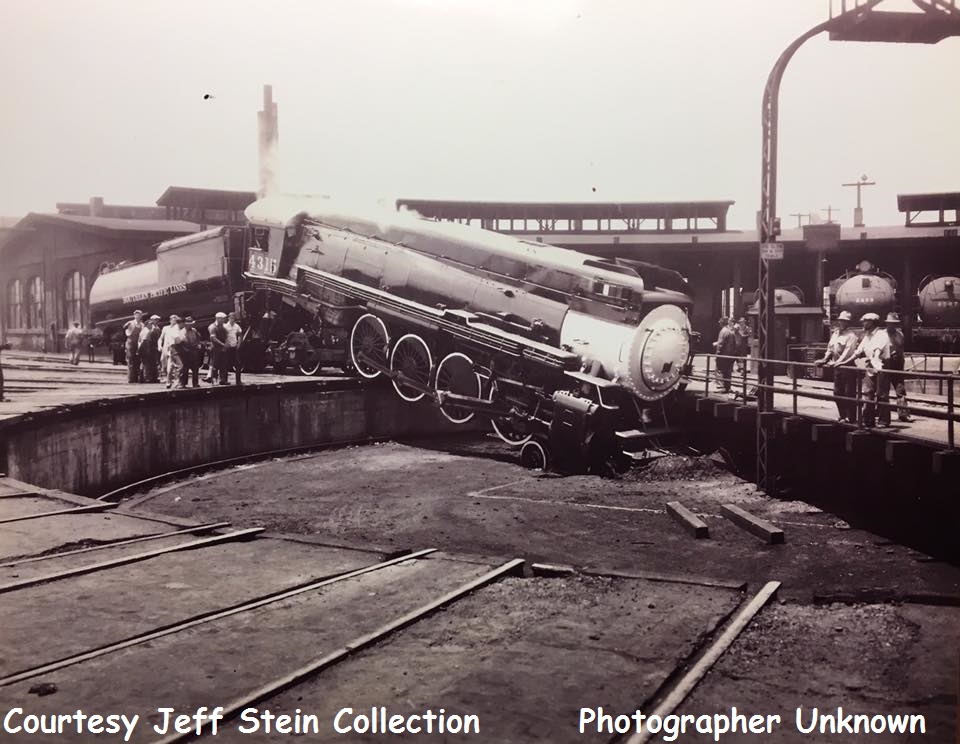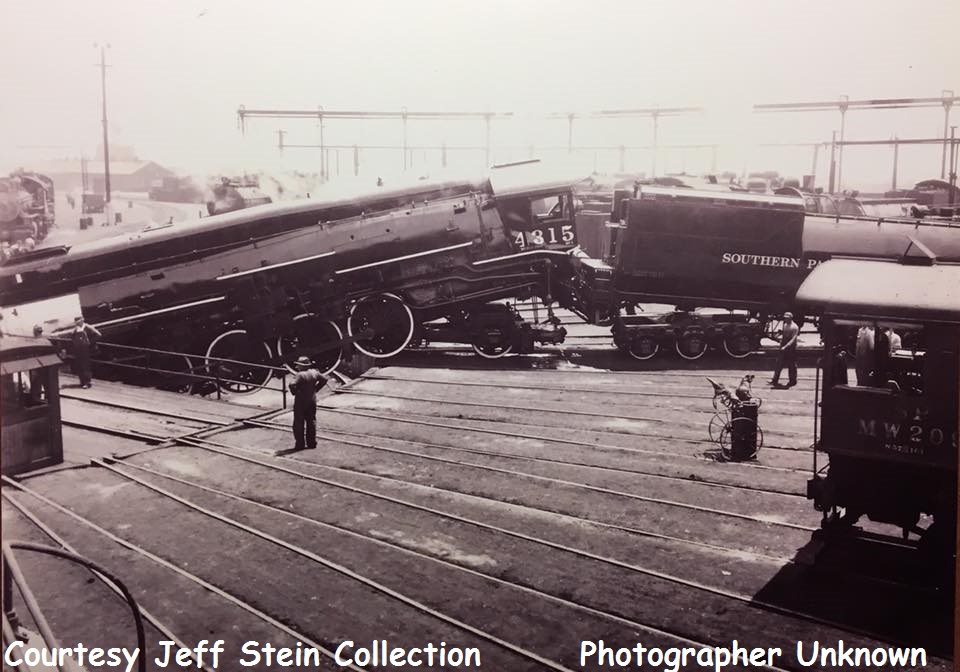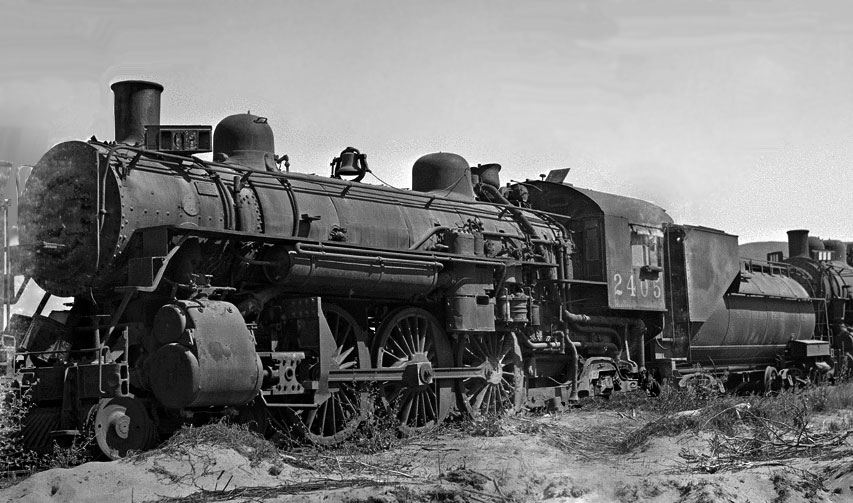|
The "roundhouse corollary" of the third law of thermodynamics stipulates that a parked locomotive will remain in a maximal state of entropy [low energy of the sort displayed by switchmen] only so long as the turntable is aligned for it. For you lay people out there, this simply means that an untended locomotive will not roll towards a turntable pit of its own volition unless the turntable is misaligned relative to it. Science has never fully explained this, only suggesting that, unshielded and unobstructed by a turntable, the unoccupied space of a turntable pit somehow stimulates a locomotive's propensity to do work, but only in a direction towards the pit.
Hundreds of hostlers, engineers and roundhouse workers fell victim to the roundhouse corollary over the years. Anyone who has ever worked for a railroad knows at least three individuals who have seen a recently vacated charge take a dive into a pit, and at least one who was aboard when same took place. This can be partially explained by railroad workers' own general propensity to exist in a maximal state of entropy while performing what is loosely characterized as "work".
Below we see the results of such a brush with the laws of physics at particularly inopportune time. Loco 4315 was an SP showpiece, second class, at the time. It was the first SP mountain-type to receive a "skyline casing" atop its boiler that conformed with its classier Yellowjacket (Daylight 4-8-4) cousins. Perhaps because of this, the company selected 4315 to debut the second season of the eastbound Treasure Island Special out of Oakland on June 22, 1940. The Treasure Island Special was just a hair below top flight, thus not worthy of a Yellowjacket it seems, even on its inaugural day. The 4315 sparkled. Especially for the event, it received the full striping treatment on wheels and running boards that had largely disappeared in the late 1920's.
The extra effort was all for naught, as just before departure time, 4315 fell victim to the roundhouse corollary. SP hoped to cover up the embarrassing affair, but Oakland was a hotbed of railfans even back then, and who should stumble into the roundhouse but noted railfan Fred Stindt, who fully recorded the company's remedial action, and later sent photos to Railroad Magazine, which published one full-page in 1942, earning Fred a trip to SP's doghouse for awhile. Fred was not SP's worst public relations problem, however, as somebody tipped off an Oakland Tribune photographer who had been waiting over at the Mole for the ceremonies. He hurried to the roundhouse and clicked off a shot that appeared four columns wide in the next day's edition.
The only available substitute that was under full steam was elderly Harriman P-1 #2405, which itself had been rescued only a short time prior from a state of advanced decay in a Bayshore deadline. The sight of this old wheezer on the head of the 49er was another black eye for the company. The next day, when the Tribune photo hit the newsstands, one wonders if Division Superintendent G. E. Gaylord temporarily descended into a state of near apoplexy.
The following three photos come courtesy of Jeff Stein through the good offices of Walter Boland. Jeff is unsure of who took the photos, but it is likely that they were the work of Fred Stindt, though it is reasonable to assume that other photographers were eventually in attendance beyond the aforementioned Tribune photographer. Certainly these sort of events draw employee cameras out of the woodwork.
Walter's father, Fred, wrote of a similar 1930's incident at Mission Bay involving 4355, a "hoodoo" locomotive according to Fred for all of the scrapes it ran into during the course of its career. Fred's The Saga of 4355, along with many other personal stories from his 52 year career can be found by consulting Fred's bio page. The 4315, on the other hand, seems to have let a relatively placid existence following its brief plunge into notoriety. Thanks Jeff and Walter!
We've drawn a few of the above details from a fine article by R. E. Field, "A Bad Day at West Oakland", which appeared on pages 6-12 of SP Trainline, September, 2013. It features coverage of the affair as told to Field by Stindt in 1955, and includes Stindt and Tribune photos, along with a down-to-earth discussion of probable cause. mmmmmm
(click on the photos for larger images)

above: The 4315 sits in the pit after the headlight had been removed to clear the wrecker's sling, but before the hook arrived. Groups of men are kibitzing as they waited, but no other photographers are evident. below: Roundhouse goat #209 sits hemmed-in and a cutting torch rig stands at the ready.


above: As the hook slowly lifts the loco, M/W laborers fill-in the void with cribwork. In such situations, the wisdom is that the loco is not lifted all at once, as sometimes "things" happen. During a derailment cleanup, this writer once witnessed a similar sling snap apart, causing a 200 ton locomotive to fall about six feet to the ground with a massive thud. Worse, the release of tension cause the hoisting cable to swoop around in a 180 degree arc, narrowly missing, but scattering about twenty workers. Many of railroading's lessons were hard earned, yet subsequently forgotten in the heat of the moment. below: Substitute P-1 Pacific #2405 sits in the Bayshore deadline in 1935, awaiting resurrection, which may have come as soon as the next year, during a brief upswing in business. The loco was one of the few P-1's that received a booster without being upgraded to a P-4. Despite the disparity of age and capabilities, the two locos were scrapped only about eighteen months apart in the early 1950's. Note that the image of 2405 is heavily retouched due to the poor condition of the negative from which it came (photographer unknown; Wx4 collection).

|
|